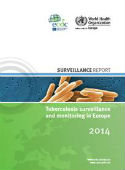Tuberculosis surveillance and monitoring in Europe 2014

Download
This is the sixth report launched jointly by the European Centre for Disease Prevention and Control (ECDC) and the WHO Regional Office for Europe (WHO/Europe) following on from reports under the EuroTB Project, established in 1996.
Despite notable progress in the past decade, tuberculosis (TB) is still a public health concern in most of the countries within the WHO European Region. Countries outside of the European Union (EU) and European Economic Area (EEA) still suffer from high rates of TB and multidrug resistant (MDR) TB, while EU/EEA countries have a significant number of TB cases among vulnerable population groups, such as people of foreign origin and prisoners. Other socioeconomic determinants and risk factors (e.g. HIV co-infection) also contribute, as documented in literature, even if not explicitly mentioned or dealt with in this report due to the fact that they are not included in routine surveillance.
In 2012, an estimated 353 000 new (incident) TB cases (range 330 000–376 000) occurred in the WHO European Region, equivalent to an average of 39.4 cases (36.9–41.9) per 100 000 population. This represents about 4% of the total burden of incident TB cases in the world. Eighty five per cent of incident TB cases in the Region occur in the 18 high-priority countries.
In collaboration with national and international partners and civil society organisations, WHO Regional Office for Europe has been implementing the Consolidated Action Plan to Prevent and Combat Multidrug- and Extensively Drug-Resistant Tuberculosis and helping Member States to adopt evidence-based interventions to improve TB and multidrug- and extensively drug-resistant TB (M/XDR TB) prevention and control. Almost all high-burden MDR TB countries have prepared and finalised their national MDR TB action plans in line with the regional plan.



